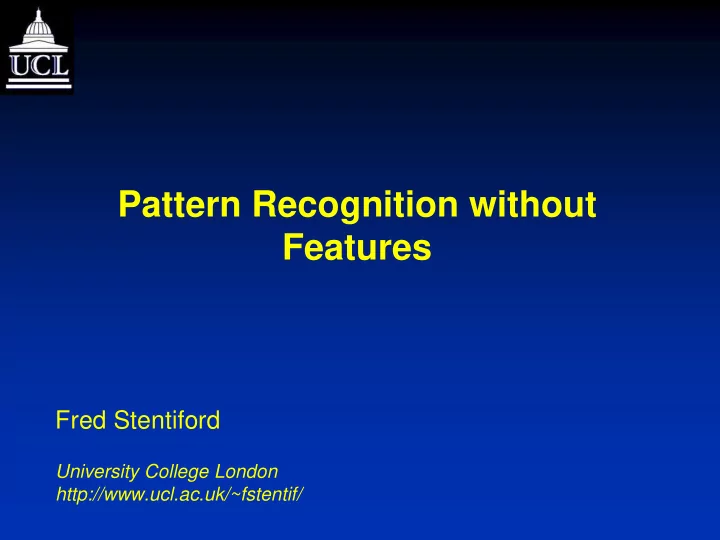

Pattern Recognition without Features Fred Stentiford University College London http://www.ucl.ac.uk/~fstentif/
Issues Selection of Features Training Process
Commonality Reference Candidate
Graphical Similarity Representation Pixels are represented as nodes Nodes possess the properties: - Location of pixel - Brightness gradient orientation A relationship exists between a pair of nodes if their properties and relative orientation match that of a pair in a second image. A maximal clique is the largest subset of nodes that all match and possess an orientation relationship with each other.
Cliques of Matching Pixels φ 34 Φ’ 34 x 4 y 4 x 3 y 3 φ 42 Φ’ 35 Φ’ 42 φ 35 φ 45 Φ’ 45 φ 41 Φ’ 41 φ 23 φ 31 Φ’ 23 Φ’ 31 φ 53 Φ’ 53 x 5 y 5 φ 52 Φ’ 52 x 2 y 2 φ 14 Φ’ 13 Φ’ 14 φ 13 φ 51 Φ’ 51 φ 12 Φ’ 12 x 1 y 1 Similarity = size of maximal clique
Yale Face Database A
Yale Face Database A
Face Matching 1764 reference points Gradient Directions Relative orientation ε 1 <19 ° ; Gradient direction ε 2 <55°;
Matching Close-up showing matching gradient orientations
Results - Expressions 3500 3000 Happy Maximal clique size Surprised 2500 Wink Sleepy Glasses 2000 Sad No Glasses 1500 1000 1 2 3 4 5 6 7 8 9 10 11 12 13 14 15 Subject No errors
Results - Illumination Gradient direction not affected in many areas
Results - Illumination 1800 1600 Maximal clique size Rightlight 1400 Centrelight Leftlight 1200 1000 800 1 2 3 4 5 6 7 8 9 10 11 12 13 14 15 Subject No errors
Results - Occlusions 1200 1000 800 Maximal clique size Top Surprised Left Surprised 600 Right Surprised Bottom Surprised 400 Errors - bottom:6/15 200 0 1 2 3 4 5 6 7 8 9 10 11 12 13 14 15 Subject
Results - Occlusions
Results - Occlusions
Neuron Sensitivity Certain neurons are sensitive to brightness gradient vector orientation (Podvigin 2001)
Benefits of the Approach Avoids the need for feature selection No training data required Automatic location of match Displays immunity to distortions Potential for parallel implementation
Recommend
More recommend